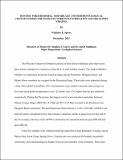BENTHIC FORAMINIFERAL ASSEMBLAGE AND SEDIMENTOLOGICAL CHANGES WITHIN THE PLIOCENE YORKTOWN FORMATION, SOUTHEASTERN VIRGINIA
Author
Spivey, Whittney E
Abstract
The Pliocene Yorktown Formation consists of four distinct lithologic units that record three marine transgressive sequences along the U.S. mid-Atlantic margin. The Sunken Meadow Member was deposited during the Zanclean Stage and the Rushmere, Morgarts Beach, and Moore House members are assigned to the Piacenzian Stage. These units were deposited during a time when global atmospheric CO2 concentrations were similar to present, and average sea-level and mean global temperatures were ~25 meters and ~3°C higher than the pre-industrial, respectively. During the Piacenzian, the largest cool to warm transition took place between Marine Isotope Stages (MIS) M2 (3.3 Ma) and M1 (3.25 Ma) recorded in the Rushmere and Morgarts Beach sediments. The mid-Piacenzian Warm Period (~3.264--3.025 Ma; mPWP) is an interval widely considered to have had climatic conditions similar to projections for the end of the 21st century; the base of the mPWP is defined by the transition between peak MIS M2 and peak MIS M1. Forty-five samples were collected along the James River near Rushmere, Virginia, and at Pipsico Boy Scout Camp, Spring Grove, Virginia and were analyzed for benthic foraminifer community and sedimentological changes between each member of the formation. These data are useful boundary conditions for shallow, near-shore environments for future global climate models. Discernible differences in grain-size distribution occur between the Sunken Meadow and Rushmere members; generally, the Sunken Meadow Member is composed of coarser sands, has less mud, and has a higher percentage of sand and phosphatic and glauconitic grains than the Rushmere Member. These sedimentological changes are often subtle in outcrop and occur within decimeters of the contact between the two units, giving the appearance that the two units are conformable in some areas. The most notable change in grain-size occurs at the conformable boundary between the Rushmere and Morgarts Beach members, where the average percentage of sand decreases from ~60% in the Rushmere Member to ~16% in the Morgarts Beach Member. Foraminiferal analysis distinguishes six biofacies across the entire Formation--two in the Sunken Meadow Member, three within the conformable Rushmere-Morgarts Beach members, and one in the Moore House Member. The Sunken Meadow Member represents a marine transgression, where changes in benthic foraminiferal assemblages and grain-size distribution indicate up-section deepening of water depth. Deposition of this unit has been interpreted as a mild temperate shallow-shelf setting with normal marine salinity based on the molluscan assemblage. This unit likely records the maximum phase of the transgression (maximum flooding). The Rushmere-Morgarts Beach members record the most extensive transgression in the Pliocene. Grain-size analysis and benthic foraminiferal assemblages indicate a shift in depositional environment from an open, middle shelf environment in the Rushmere Member to a restricted lagoonal environment in the Morgarts Beach Member. The molluscan assemblage indicates a subtropical to tropical climate. The least extensive Pliocene transgression is recorded in the Moore House Member. It likely represents a cooler temperate environment and the formation of offshore bars in the Salisbury Embayment.
Subject
Date
2021-12-03
Citation:
APA:
Spivey, Whittney E.
(December 2021).
BENTHIC FORAMINIFERAL ASSEMBLAGE AND SEDIMENTOLOGICAL CHANGES WITHIN THE PLIOCENE YORKTOWN FORMATION, SOUTHEASTERN VIRGINIA
(Master's Thesis, East Carolina University). Retrieved from the Scholarship.
(http://hdl.handle.net/10342/9713.)
MLA:
Spivey, Whittney E.
BENTHIC FORAMINIFERAL ASSEMBLAGE AND SEDIMENTOLOGICAL CHANGES WITHIN THE PLIOCENE YORKTOWN FORMATION, SOUTHEASTERN VIRGINIA.
Master's Thesis. East Carolina University,
December 2021. The Scholarship.
http://hdl.handle.net/10342/9713.
May 11, 2024.
Chicago:
Spivey, Whittney E,
“BENTHIC FORAMINIFERAL ASSEMBLAGE AND SEDIMENTOLOGICAL CHANGES WITHIN THE PLIOCENE YORKTOWN FORMATION, SOUTHEASTERN VIRGINIA”
(Master's Thesis., East Carolina University,
December 2021).
AMA:
Spivey, Whittney E.
BENTHIC FORAMINIFERAL ASSEMBLAGE AND SEDIMENTOLOGICAL CHANGES WITHIN THE PLIOCENE YORKTOWN FORMATION, SOUTHEASTERN VIRGINIA
[Master's Thesis]. Greenville, NC: East Carolina University;
December 2021.
Collections
Publisher
East Carolina University

